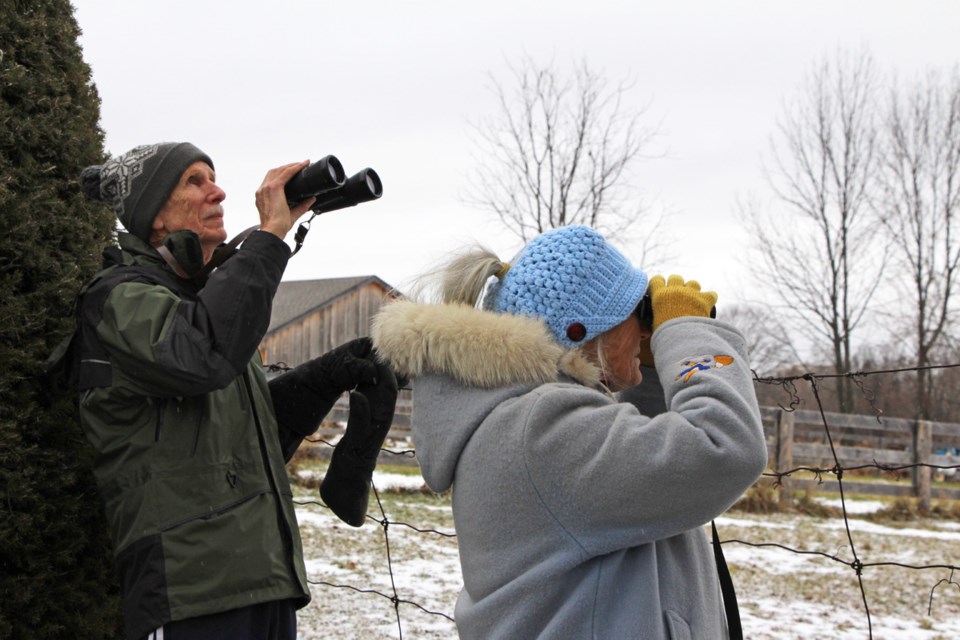This Saturday, don’t be surprised if you see people with binoculars peering up at trees or into bushes as they walk or drive their cars throughout the region. Dec. 19 is the day citizen science volunteers will be taking part in the annual Christmas Bird Count.
The event, organized by the Orillia Naturalists’ Club, is part of one of North America’s longest-running wildlife monitoring programs.
To learn more about what the Christmas Bird Count is all about, we spoke to Fern Splichal of the Orillia Naturalists’ Club, who co-ordinates the local bird count.
What is the Christmas Bird Count?
This is a yearly event that provides a snapshot of the birds found within a 24-kilometre circle, centred on Bass Lake. The circle is divided into nine separate territories, each covered by a team of birders. Our count is part of a citizen science program and wildlife survey operated by Birds Canada and the National Audubon Society. All Christmas Bird Counts are carried out on a single 24-hour day, chosen by the local organizing group, between mid-December and mid-January. The purpose is to identify bird population trends and guide conservation efforts.
How did the Christmas Bird Count begin and how long has it been going?
The Christmas Bird Count began over 100 years ago when American ornithologist Frank Chapman proposed a conservation-oriented alternative to a traditional Christmas Day competition to hunt the most birds and small mammals. His initiative to identify, count, and record all the birds found on Christmas Day in 1900 has turned into one of North America’s longest-running wildlife monitoring programs. Here in Orillia, a small group of avid birders from the Orillia Naturalists’ Club started the Christmas Bird Count in 1980. We have the data from our annual Orillia Bird Counts since 1981.
Why is the bird count important?
The Christmas Bird Count allows us to see the trends over time in the numbers of birds and bird species in our area. As an example, in 2018, we had new highs for red- and white-breasted nuthatches and the northern cardinal. And, for the first time, our count included a greater white-fronted goose, a northern shoveler, and a turkey vulture. As this is submitted to Birds Canada and to Audubon, trends over North America are noted. Our report to Birds Canada also includes the weather conditions of the day and whether the waterways were open, partially frozen, or completely frozen. This can influence our ducks, swans, and gull counts. The annual survey helps to assess the health of bird populations, which can then help to identify environmental issues and guide conservation action.
Who takes part in the local Christmas Bird Count?
Last year we had 44 participants who spent a total of over 56 hours in the field and covered 705 km, mostly by car, on count day. Occasionally, our teams take a walk in areas that cannot be seen well by car. Volunteers do not have to be experienced birders to participate, just have an interest in trying to identify birds. A pair of binoculars obviously helps! In past years, when we could carpool, new birders would travel with the experienced birders. They would work as a team to spot and identify birds. We average about 55 species of birds each year and count over 5,000 individual birds.
How will the pandemic affect this year’s event?
This year, with COVID, our bird count is being carried out somewhat differently. Instead of carpooling, our team leaders (for each of the nine territories) have divided their territory and assigned individuals to travel in their own cars. Another option is to have two cars follow each other and confer from time to time in an outside, safe setting. And the third option is to simply observe backyard bird feeders from home. In these COVID times, being out of doors is so important, and birding — even having a feeder in your yard — can provide a lot of pleasure!
To learn more about the annual Christmas Bird Count and the activities of the Orillia Naturalists’ Club, visit orillianaturalistsclub.ca.